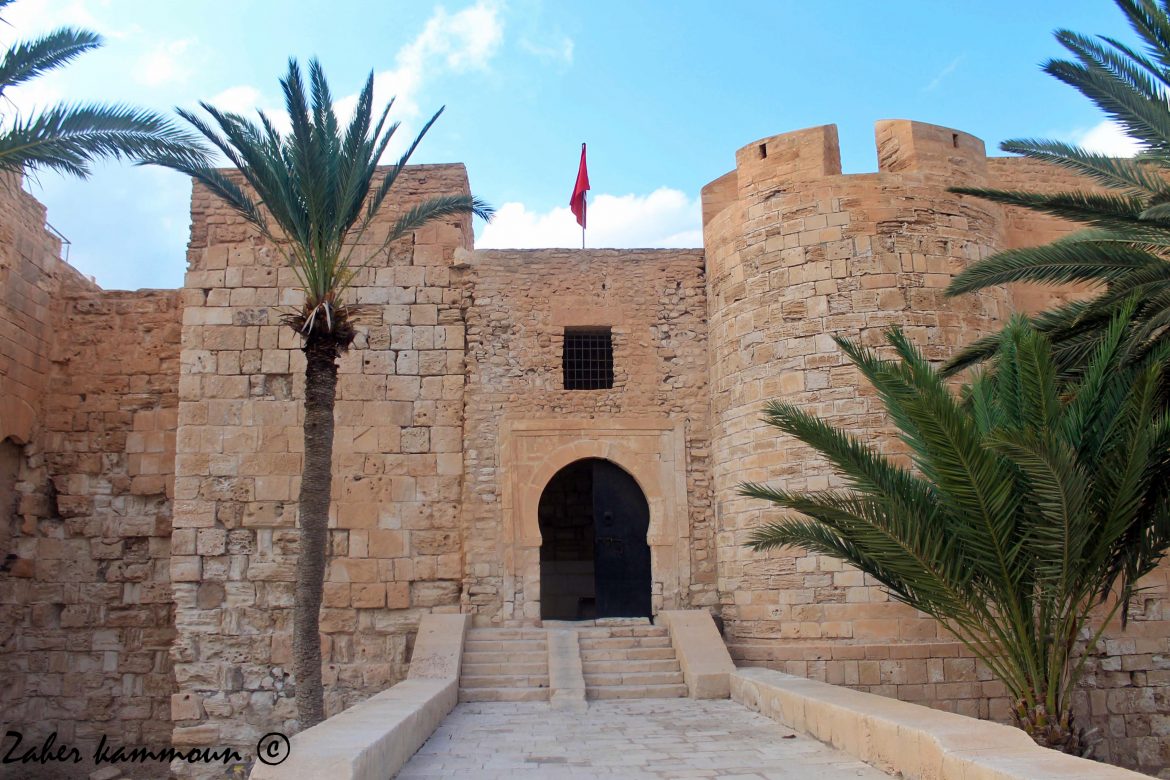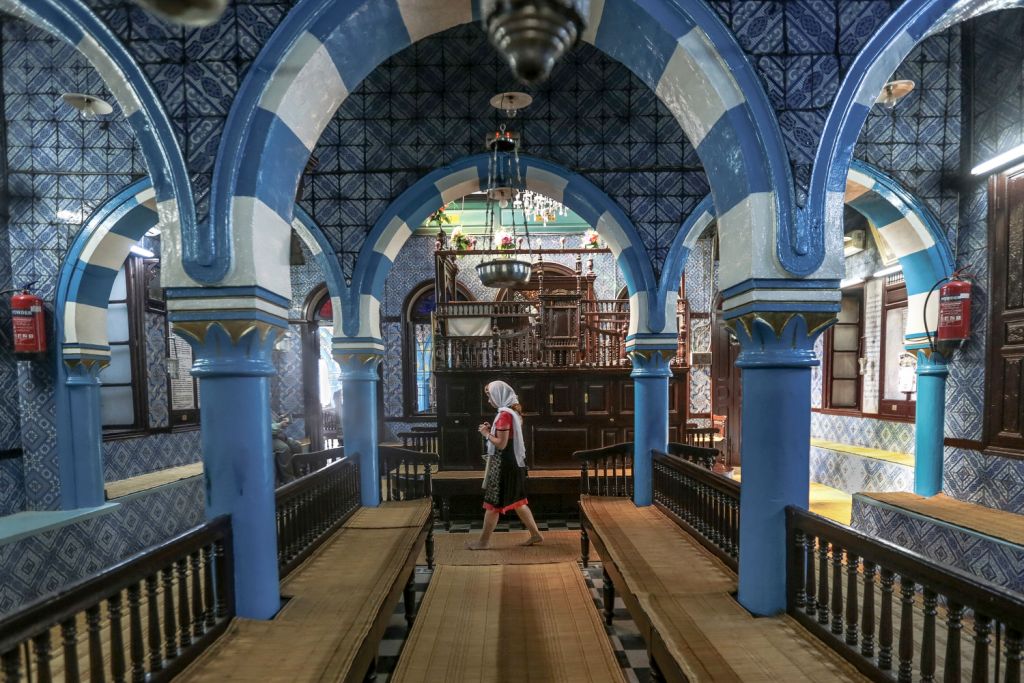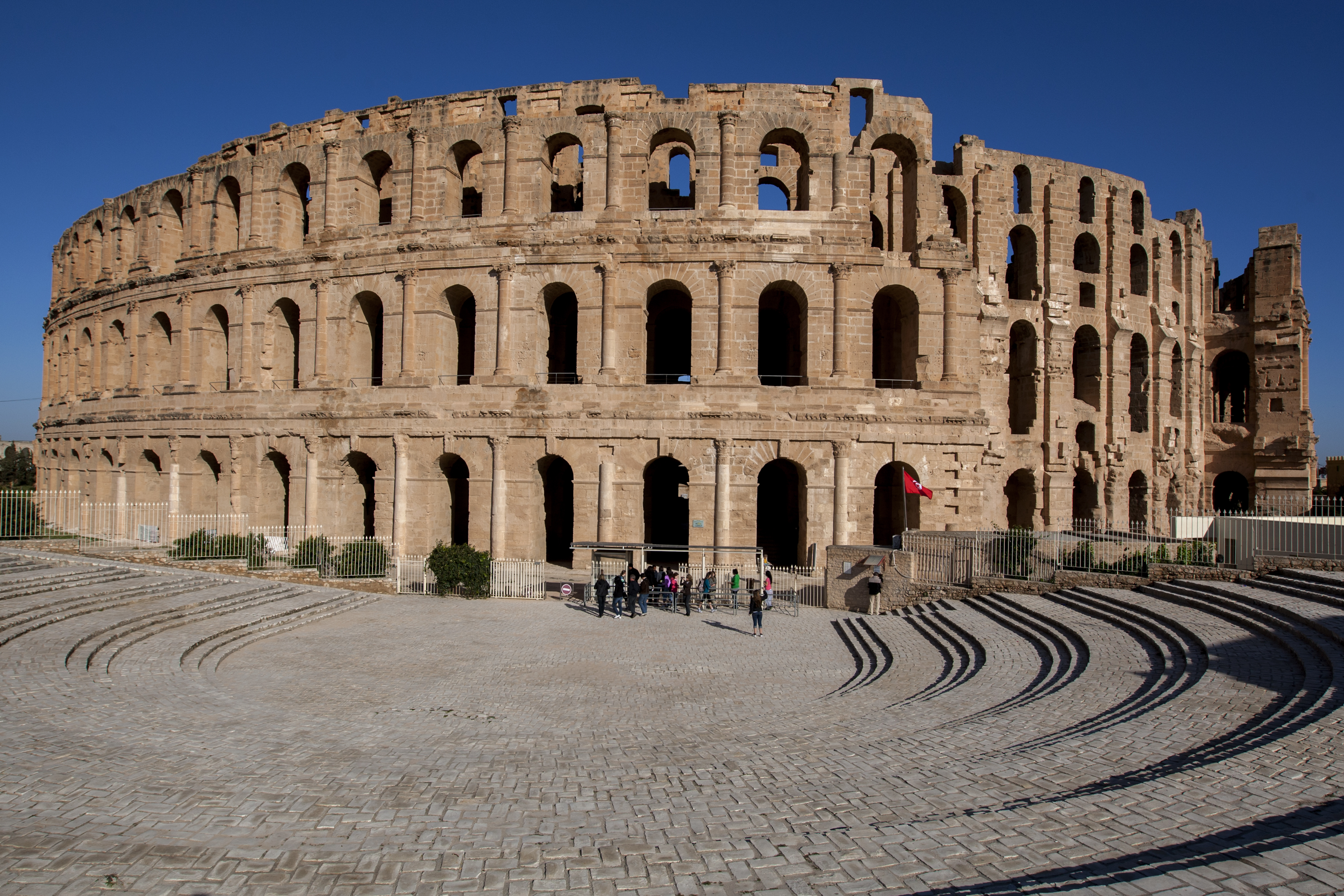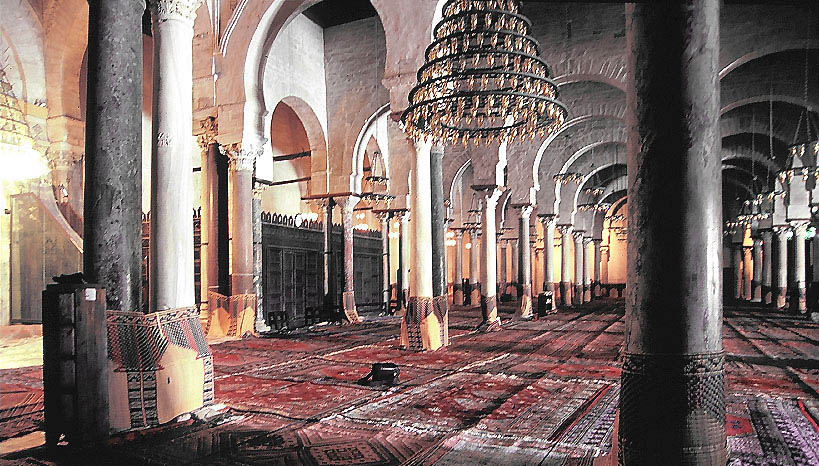This route moves from south to north.
ISLAND OF JERBA
The island of Jerba has a mixture of sandy beaches, desert heat and wonderfully idiosyncratic architecture. Berber culture is dominant – envision women wrapped in cream-striped textiles and straw hats. This is Homer’s Land of the Lotus Eaters, a place so seductive that it’s impossible to leave; ‘drugged by the legendary honeyed fruit’, poor Ulysses had a lot of trouble prising his crew away.
Luxury hotels line beautiful Sidi Mahres beach south of Houmt Souq. There were no tourists.
HOUMT SOUQ. This island’s capital is situated in the middle of the north coast. It’s a charming small town, full of outdoor cafes, shops and a handful of ancient funduqs (converted Ottoman-era camel caravan inns or caravansérail), the town’s architectural trademark. All the magnificent cedar trees on the main street had been cut down, the stumps removed and in the process, the brick sidewalks had been destroyed (and not repaired). I found walking around Houmt Souq kind of depressing.
A causeway built in Roman times links the east of the island to the mainland and 24-hour car ferries go from western Ajim and El-Jorf.
From the louage station, it was a short walk to the Hotel Marhala, the cheapest in town. But right next door was the Augerge de Jeunesse, so at 8TD per night, I got a private room with an ensuite bath. That night, I socialized with 5 Boy Scout leaders. They normally go on camping trips all over Tunisia and have a penchant for lighting campfires.
Houmt Souq Old Town. Jerba’s traditional architecture is delightful and unlike any other in Tunisia. Domes dot the skyline and all is bathed in a dusty whitewash. A market town, there’s no escaping the carpets, jewelry, ceramics, bric-a-brac, ubiquitous leather goods and kaftans. Highly atmospheric with plenty of pretty squares where you can people-watch.
I was hustled by a guy insistent that I see the spice souq. After smelling every spice, herb and essential oil in the place, the fellow was amazed that I did not want to buy anything that I simply didn’t want.
Borj Ghazi Mustapha. This fairy-tale fort, on the beach 500m north of town, was first built in the 13th century by the Aragonese. It is doubtful if paying the 7TD entry was worth it. The information inside was not in English, the inside is a junkie and kind of depressing and seeing it from the outside only is just as good.

El-Ghriba. The most important synagogue on Jerba and the oldest in North Africa is signposted 1km south of Erriadh, 7km south of Houmt Souq. Blank from the outside, the interior is an exquisite combination of glowing blue tile work and moodily dark wooden furniture. The inner sanctuary, with its elevated pulpit, is said to contain one of the oldest Torahs in the world. As stated above, Ghriba was the site of a terrorist attack in 2002 killing 19 tourists and injuring 30. There was heavy security: a baggage scanner and many police for security.

Again, I’m not sure if this is worth the taxi out and back to here. A donation is requested to visit. I hitchhiked back to Houmt Souq.
The hours are confusing: Closed Saturdays, Winter 09:00-12:00 and 15:00-17:00, Summer 09:30-12:00 and 14:30-16:30.
Of course, I arrived at noon and so had 3 hours to kill. I walked the 1km back to Erriadh town centre just as the Sunday market was closing down. Spread over 3 blocks of one street, it was amazing to watch everyone pack tons of stuff they had optimistically set out to sell. I also found an Internet café where I was able to access the internet, update posts and do some business, scanning and photocopying documents, that were long overdue. I also downloaded stuff onto my Kindle.
Guellala Museum. This museum is truly local and is rich in Djerba’s history, it shows how the island’s industries and crafts are worked on and the extremely interesting ceremonies regarding marriage in Djerba, this museum will give a traveller some insight into the strange island of Djerba.
Tourist Zone. All the large resorts are at least 10kms east of Houmt Souq on the northeast and east coasts of Jerba. The best beach is next to the Club Med. I was tempted to go out just to have a look. It was cool, windy day where a puff jacket was necessary to stay warm. Buses go out to the zone several times a day.
Mareth Museum is a military museum, in Mareth, located between Gabes and Medenine, the Mareth Line Museum deals with the Second World War history. In March 1943, Rommel used this bunker line to resist Montgomery’s VIIIth army advance.
GABES is a big city on the east coast not even mentioned in the Lonely Planet. The oasis of Gabes is a tentative UNESCO WHS.
Jara Mosque.
Gabès Lighthouse
Oudhref Open-air village museum. Just north of Gabes.
(From my original route). As I am up at this hour anyway, on January 18th, I took the 5 am bus 2½ hrs to Gabes, then a louage to Kibili and a second louage to Tozeur, arriving after 7 hours of travel.
From Tozeur, I planned on taking the 3 am bus to Sfax but slept in (I guess failing to wake up at 2 am is sleeping in) and instead took the much more civilized train at 6:30 am. The train never arrived. I guess that is how things work in Tunisia. So I walked back to the louage station taking 3 separate vehicles via Safx to El-Jem. It was looking like my ambitious travel day was going to fall short of my ultimate destination.
Ras Thyna Lighthouse. About 12 km south of Sfax.
SFAX (pop 265,000)
On my way between Tozeur and El-Jem, it is the country’s second-largest city, is dull and most tourists head straight through on the way to the south.
Médina de Sfax. A tentative WHS (17/02/2012), the busy picturesque medina is surrounded by ancient crenellated walls. Souq.

Dar Jellouli Museum (Regional Museum of Arts and Folk Traditions) in a palace located in the heart of the ancient city of Sfax. The house was built by Andalusian Muslim refugees fleeing from the Spanish persecutions in the 17th century, lived in by one family, was a medical clinic in 1934 and in 1939, an artistic centre under the direction of the French university professor Lucien Golvin. Typical of Tunisian housing it has a square courtyard in the centre.
The museum shows the traditional daily life of the 18th-century Sfax, traditional costumes, oil paintings and Islamic calligraphy.
Sfax Archaeological Museum. Covers all periods of Tunisia’s history, most Roman from the archaeological site of Thyna (Thaenae) 12 km south of Sfax.
Grande Mosquee has a 9th-century minaret.
Ville Nouvelle has some of the best-preserved 20th-century architecture in Tunisia.
CENTRAL TUNISIA
The golden-sand coast stretching from the city of Sfax to the tip of Cap Bon has drawn millions of European sun-seekers since the 1960s. Spared the high-rise towers that blight the Mediterranean elsewhere, the resorts are never far from Roman ruins, Berber villages or seldom-visited countryside.
Home to El-Jem, its most impressive Roman monument and Kairouan, one of Islam’s most holy cities. It took me 5 louages to arrive in Kairouan late in the day.
EL-JEM (pop 18,300)
Roman Coliseum rises up from a low plateau halfway between Sousse and Sfax, dwarfing the tiny modern town around it. Built 2000 years ago by olive oil traders with money to burn, it’s a culmination of a couple of centuries of engineering expertise. It included state-of-the-art features including a movable floor – all the better to showcase gladiatorial combat, executions of Christians and other forms of Roman popular culture.
The Coliseum of Thysdrus is a magnificent structure. It is an oval – 149X124m – and able to hold 30,000 spectators in 5 tiers of seating (Rome’s Coliseum held 43,000). The structure has 5 levels of great keystone arches holding up the 5 levels of walkways giving access to the seating. You are able to walk through the hypogeum, the underground area that held the animals and gladiators raised on elevators to the area of combat. It was originally covered by a wood ceiling.

Its beautiful archaeological museum is home to an outstanding mosaic collection, better than that in the Bardo: some wonderful geometrics and many depicting animals (including a great peacock) and gladiators.
Travelling by bus and louage, I stopped here to see the coliseum and had a cruise through the museum all in one hour carrying my backpack. It had taken an hour to fill the louage and I had great timing to snag the last seat. As I was putting my pack in the back, I fellow sat in my seat, I got a little upset and he gave it up. It was then 40 minutes north to Sousse and then 45 minutes west to Kairouan. There are also trains but their timing is not nearly so convenient as the louages.
The countryside is flat and one big olive grove. Fences between fields are hedgerows of impenetrable giant prickly pear. Agave also grow well in this semi-desert.
Mahdia. Scenic and historic. Mahdia Museum
Lamta Archaeological Museum started in 1992 to explain the history of the area from the 13th century b.c.e. Phoenicians. The Punic funeral remains inside the museum illustrate the changes in culture and the methods of manufacture.
The settlement chose wisely during the Roman period aligning itself militarily with Rome and when that was split it chose to back the winner, Julius Caesar.
Monastir. Unattractive but with a dramatic seaside ribat (fort) and Bourghiba’s mausoleum. Ile Kuriat Lighthouse.
SOUSSE Loud, crowded but beautiful, Boujaffar Beach is a favourite.
Medina of Sousse. UNESCO listed in 1988, it is a typical example of the architecture of the early centuries of Islam in the Maghreb: first, because of the time it was built (at the dawning of Islamic civilization, making it one of the earliest constructions after the Islamic conquests in the Maghreb), and second, because of the location of the Medina, a site that required protection against piracy and plunder. It has a Kasbah, fortifications, the Great Mosque and the Archaeological Museum.

Sousse Archaeological Museum.
Dar Essid Museum is an art museum located in a palace in the medina that belonged to a family of aristocrats. The museum retraces the daily city life in Sousse in the 18th and 19th centuries.
Ribat of Sousse. Initially constructed by the Aghlabid ruler Ibrahim the Great in the 8th century, it was expanded in 821 to two floors, a basement and battlements were added, as well as thirty rooms for guards to live complete with a bathroom and toilet and a mosque. A water basin which collected rainwater for drinking and washing.
KAIROUAN (pop 117,900)
With its Grande Mosquée, the oldest in North Africa, the walled city of Kairouan is considered the fourth-holiest site of Islam. The medina is a beautiful place to wander with crumbling, white-washed, blue- and green-edged houses.
It was here that Arabs established their first base when they arrived from the east in AD 670 – Kairouan became so important in the Islamic hierarchy that seven visits now equal one visit to Mecca. This is also the rug capital of the country (although I saw no rug shops).
The louage station was in a remote place but one of the guys in the louage gave me a free taxi ride to my hotel, Hotel Serba. It was described in the LP as a “hostel-like dump” and it was (no wifi, shared bathrooms with no toilet paper or toilet seats), but the price is right for a hotel (20TD with an above-average breakfast), a comfortable bed and in an awesome location opposite the Bab ech Chouhada (the main entrance into the medina).
Medina. Little is mentioned in the LP about the amazing 15m-high crenulated wall surrounding the entire medina. It is very imposing. The medina is huge and the usual maze of lanes with few people and shops only on some streets. The Grande Mosquee, Barrouta and Zaouia Sidi Sahab are inside the walls. I wandered around the atmospheric place wandering into woodworking shops, weavers working old hand and leg-driven looms, and stores that stocked all their goods on shelves behind the counter (the last time I saw this was in the 1960s in the Bowie General Store in Piapot, Saskatchewan where my mother was raised). I had the breakfast specialty: soft dough thrown into a round and tossed in a large vat of boiling oil with an egg and cooked cabbage put on top to cook inside. It was delicious in its utter greasiness and a much-needed sink with soap is provided.
Grande Mosquée. This 9th-century mosque, with its buttressed 8m walls surrounding 8,000 square meters of space, has an unadorned design in the Aghlabid Maghreb style and is a masterpiece of Islamic architecture. Founded in 670 and reconstructed in 836, it transformed Kairouan as the town moved westward to surround it. Impressions change once you step into the huge marble-paved courtyard with its sundial and surrounded by a double-arched colonnade of marble columns. The 60m-high minaret is the oldest in Tunisia. The fellow selling the 10TD ticket said it was good for the “whole” mosque and I took him at his word.


Even though I knew I couldn’t enter the oratory (prayer hall) as a non-Muslim, I was determined to see the inside, moved across to the east side and snuck in an obscure door. It is richly decorated with small, lush carpets on the floor, 17 naves and 8 beys, marble columns with antique capitals, a high rich wood ceiling, a ribbed, shell-shaped dome over the original 9th-century mihrab with its glazed tiles, minbar (the chair for preaching and the oldest in the world) and wonderful wood jali screens of the maqaura (emirs space). After touring the entire space, I was unceremoniously kicked out and the police guards with their submachine guns came. But everything was pleasant.
Puits Barrouta. A muzzled camel walks in a circle, drawing water from a holy noria (well) said to be connected to Mecca. I am drinking a wonderful freshly squeezed orange juice in the atmospheric adjoining café as I write this.
Tapis-Sabra. In the medina, this 18th-century residence of the former beys of Kairouan is now a carpet shop. It’s worth enduring the carpet spiel to see an exquisitely restored medina house and witness the women’s rug weavers at work.
Zaouia Sidi Sahab. 17th-century mosque tiled in luminescent colours and known as the ‘barber mosque’, because it contains the mausoleum of one of the Prophet’s companions, Abu Zama el-Belaoui, who used to carry around three hairs from the Prophet’s beard.

CAP BON
The golden-sand coast stretching from the city of Sfax to the tip of Cap Bon has drawn millions of European sun-seekers since the 1960s. Spared the high-rise towers that blight the Mediterranean elsewhere, the resorts are never far from Roman ruins, Berber villages or seldom-visited countryside.
Hotels are rarely crowded. There are also several small hotels and B&Bs, both in the backstreets of the popular resort towns and in the remoter coastal towns, that offer comfort and a more low-key experience.
Nabeul. Laid-back beach destination in a bustling, prosperous town.
Hammamet. Huge resorts that stretch for miles, relaxed and charming.
Kélibia and El Haouaria. Remote and largely untouristed beaches, rocky coves and pine forests.
